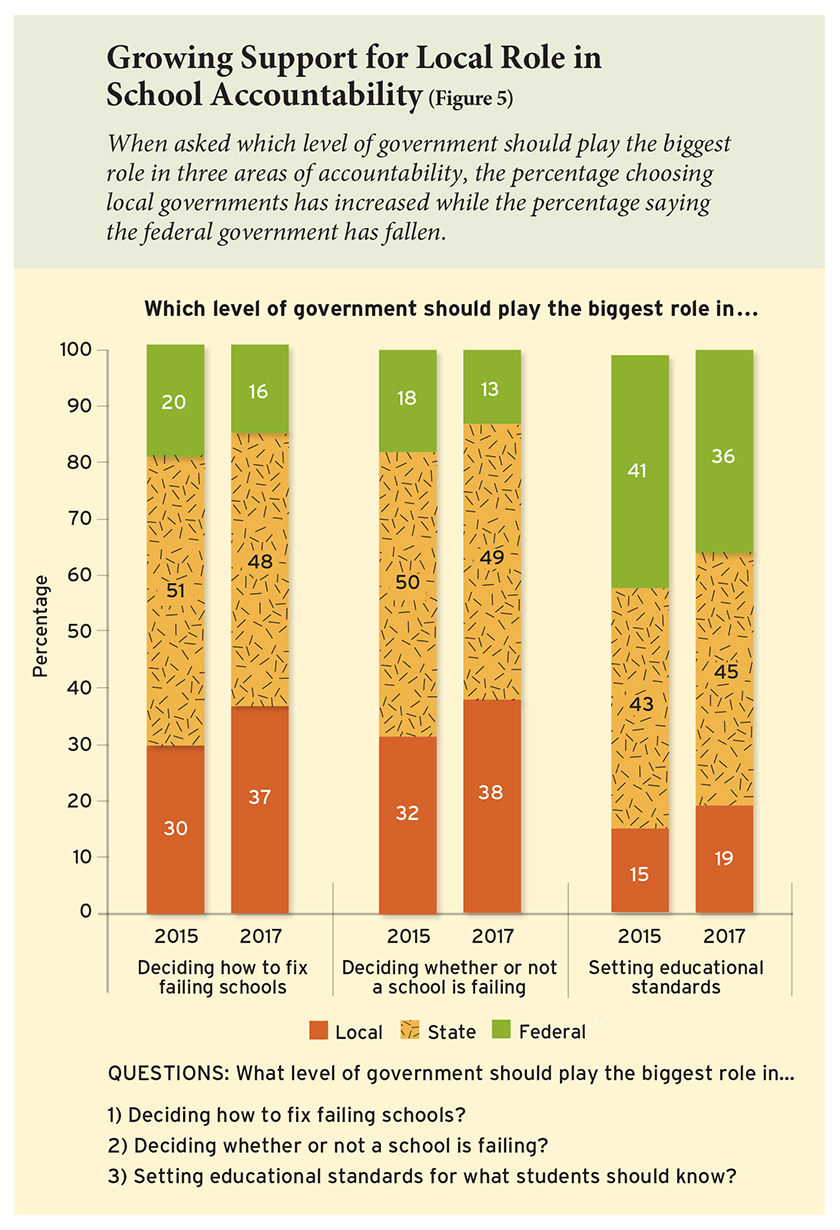 The big news out of this year’s Education Next poll is the sharp decline in support for charter schools, even among Republicans, which is going to leave us wonks scratching our heads for months. But don’t miss the findings on what we used to call “standards-based reform.” Support for common standards has rebounded, with proponents outnumbering opponents three to one. And a strong plurality of Americans want states—and not the feds, and not local school boards—to set academic standards, determine whether a school is failing, and if so, determine how to fix it.
The big news out of this year’s Education Next poll is the sharp decline in support for charter schools, even among Republicans, which is going to leave us wonks scratching our heads for months. But don’t miss the findings on what we used to call “standards-based reform.” Support for common standards has rebounded, with proponents outnumbering opponents three to one. And a strong plurality of Americans want states—and not the feds, and not local school boards—to set academic standards, determine whether a school is failing, and if so, determine how to fix it.
Perhaps not coincidentally, this is precisely where Congress landed two years ago when it passed the Every Student Succeeds Act. Lawmakers pushed key decisions to the states and, in some cases, to local communities. But there were limits. When it came to standards-setting and testing, the feds made it clear that states could not delegate their responsibilities. Uniform, statewide systems are still required, just as they have been for over twenty years.
Alas, someone needs to explain that to Arizona and New Hampshire. While both states deserve plaudits for innovative moves in recent years—Arizona for its excellent approach to school ratings under ESSA, and New Hampshire for its work on competency-based education — they have erred in enacting laws that would let local elementary and middle schools select among a range of options when it’s time for annual standardized testing. That’s bad on policy grounds, and it clearly violates ESSA.
First let’s tackle the substantive concerns. The reason that policymakers have embraced statewide standards and assessments for more than two decades is that they are proven ways to raise expectations for all students. In the bad old days, before statewide standards, affluent communities tended to ask their kids to shoot for the moon (or at least 3s, 4s, and 5s on a battery of Advanced Placement exams), while too many schools in low-income neighborhoods were happy with basic literacy and numeracy. These expectations gaps haven’t disappeared, but they have narrowed. And statewide standards and assessments at least point to a common North Star, plus provide transparency about how close students and schools are coming to achieving college-and-career-ready benchmarks.
The risk with Arizona and New Hampshire’s approach is that some schools will opt for easier tests—and that will exacerbate the expectations and achievement gaps.
As for the legal question, as this brief from Dennis Cariello makes clear, Congress debated whether to allow states to let districts choose among a menu of tests, and decided against it—at least for grades 3–8. It did open the door to such an approach in high school, where kids are already taking lots of other tests. And there’s good evidence that getting everyone to take the SAT or ACT is smart policy. But not for younger students.
To be sure, the testing landscape is going to continue to evolve, and federal policy should be supportive. Already, for example, several states have asked for waivers from ESSA to allow them to give an algebra test to some of their middle schoolers, rather than the regular assessment, so as to avoid double-testing. That strikes me as perfectly reasonable. There’s also ESSA’s “innovative assessments pilot,” which provides space for breaking new ground.
But a general balkanization of standards and testing is not allowed, for good reason. Local control has its place—but, as Americans told Education Next, it also has its limits.
— Mike Petrilli
Mike Petrilli is president of the Thomas B. Fordham Institute, research fellow at Stanford University’s Hoover Institution, and executive editor of Education Next.
This post originally appeared in Flypaper.



